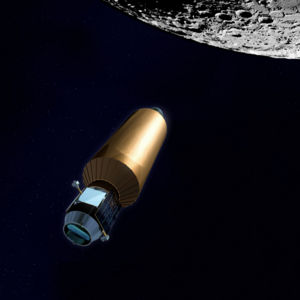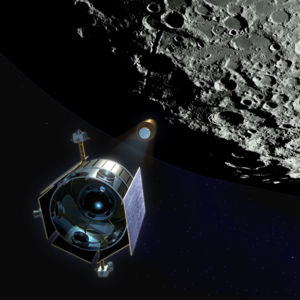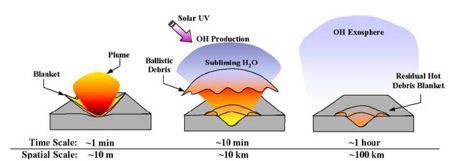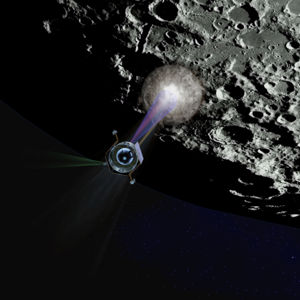Difference between revisions of "LCROSS"
| Line 62: | Line 62: | ||
*Sponsor: [[NASA Ames Research Center]] | *Sponsor: [[NASA Ames Research Center]] | ||
*Principal Investigator: [[Dr. Anthony Colaprete]] | *Principal Investigator: [[Dr. Anthony Colaprete]] | ||
| − | *[[ | + | *Project Manager: [[Daniel Andrews]] |
| + | *Co-investigator: [[Dr. Jennifer Heldmann]] | ||
| + | *Deputy Project Manager: [[John Marmie]] | ||
| + | *Payload Scientist: [[Dr. Kimberly Ennico]] | ||
| + | *Mission Operations System Team Lead & Flight Director: [[Paul Tompkins]] | ||
| + | *Space and Aircraft Mission Analysis: [[Roger Arno]] | ||
| + | *Project Systems Engineer: [[Darin Foreman]] | ||
| + | *System Safety & Mission Assurance Manager: [[Leonard Hee]] | ||
*[[Diane Wooden]] | *[[Diane Wooden]] | ||
*[[Tony Ricco]] | *[[Tony Ricco]] | ||
Revision as of 15:17, 12 August 2008
This article is a mission or probe stub. You can help Lunarpedia by expanding it.
|
LCROSS Lunar Crater Observation and Sensing Satellite
The Lunar CRater Observation and Sensing Satellite (LCROSS), was purpose built to search for H2O on the Moon and is to be launched as a secondary payload on Lunar Reconnaissance Orbiter. The smaller secondary payload spacecraft will travel with the Lunar Reconnaissance Orbiter (LRO) satellite to the moon on the same Atlas-Centaur EELV rocket to be launched from Cape Canaveral Air Force Station, Florida. After launch, the 'secondary payload,' LCROSS spacecraft will arrive in the lunar vicinity independent of the LRO satellite. On the way to the moon, the spacecraft's two main parts, the Shepherding Spacecraft (S-S/C) and the Centaur Upper Stage will remain coupled.
As the spacecraft approaches the moon's south pole, the 2000kg Centaur will separate and then will impact a crater in a polar region of the moon 7 hours later at 9,000 km/hr, producing an explosion 200 times more powerful than that of Lunar Prospector and equivalent to about 2,000 pounds of TNT (6.5 billion joules). The blast will jettison a plume of material out of the crater where astronomers can search the debris for signs of lunar water. The plume from the Centaur crash will develop as the Shepherding Spacecraft heads in towards the moon. The S-S/C will fly through the plume, and instruments on the spacecraft will analyze the cloud to look for signs of water and other compounds. Additional space and earth-based instruments also will study the huge plume, which scientists expect to be 1000 metric tons. The booster impact is set to occur sometime between May and August 2009, depending on launch dates. The other half of the LCROSS mission, weighing 700kg (the Shepherding Spacecraft), will observe the impact and then itself crash into the Moon 4 minutes later.
Most of the Moon lacks water and is extremely low in other volatiles. With a very tenuous argon astmosphere and 300° temperature swings between night and day, most of the Moon's surface is a hostile place for water. However there are a few cold, dark places where water molecules could collect and remain frozen. At the lunar poles, the sun is always low on the horizon, so some crater ridges cast shadows that keep parts of the crater floors in perpetual darkness. Temperatures in the shadows hover around 40° above absolute zero (-233° Celsius), cold enough for water ice to survive indefinitely.
"The explosion itself will likely be obscured by the walls of the target crater. Instead, what astronomers will look for is the impact plume. An expanding cone of ejecta will rise more than 6 kilometers above the lunar surface and spread outward for about 40 km in every direction. The debris is expected to shine like a 6th to 8th magnitude star—invisible to the human eye but an easy target for backyard telescopes."[1]
The LCROSS mission will help determine if there is water hidden in the permanently dark craters of one of the moon's poles. "If LCROSS's booster stage hits a patch of lunar regolith that contains at least 0.5 percent water ice, water should be detectable in the plume of ejecta," per Anthony Colaprete[1].
Science Payload
The LCROSS science payload consists of two near-infrared spectrometers, a visible light spectrometer, two mid-infrared cameras, two near-infrared cameras, a visible camera and a visible radiometer.
| LCROSS Science Loadout | |
| Instrument | Target |
| Near Infra-red Spectrometers(2) | Ice, Vapor, Grain Size, Hydrates |
| Visible Spectrometer | H2O+ (619 nm), OH (308nm), Search organics |
| Mid Infra-red Cameras(2) | Pre-impact terrain, Total Water, Ejecta Blanket |
| Near Infra-red Cameras(2) | Total Water |
| Visible Context Camera | Impact location, Plume morphology |
| Visible Photometer | Flash light curve |
| LCROSS Technical Info: Instruments[2] | |
Project Team
- Sponsor: NASA Ames Research Center
- Principal Investigator: Dr. Anthony Colaprete
- Project Manager: Daniel Andrews
- Co-investigator: Dr. Jennifer Heldmann
- Deputy Project Manager: John Marmie
- Payload Scientist: Dr. Kimberly Ennico
- Mission Operations System Team Lead & Flight Director: Paul Tompkins
- Space and Aircraft Mission Analysis: Roger Arno
- Project Systems Engineer: Darin Foreman
- System Safety & Mission Assurance Manager: Leonard Hee
- Diane Wooden
- Tony Ricco
- Geoff Briggs
- LPRP Program Scientist: Ben Bussey
- Prime Contractor: Northrup Space Technologies of Redondo Beach, Calif.
External Links
- The LCROSS Mission - Space Science and Astrobiology Division - NASA AMES
- LCROSS - National Aeronautics and Space Administration
References
- ↑ 1.0 1.1 A Flash of Insight: LCROSS Mission Update - Edited by Dr. Tony Phillips, Science@NASA
- ↑ LCROSS Technical Info: Instruments










